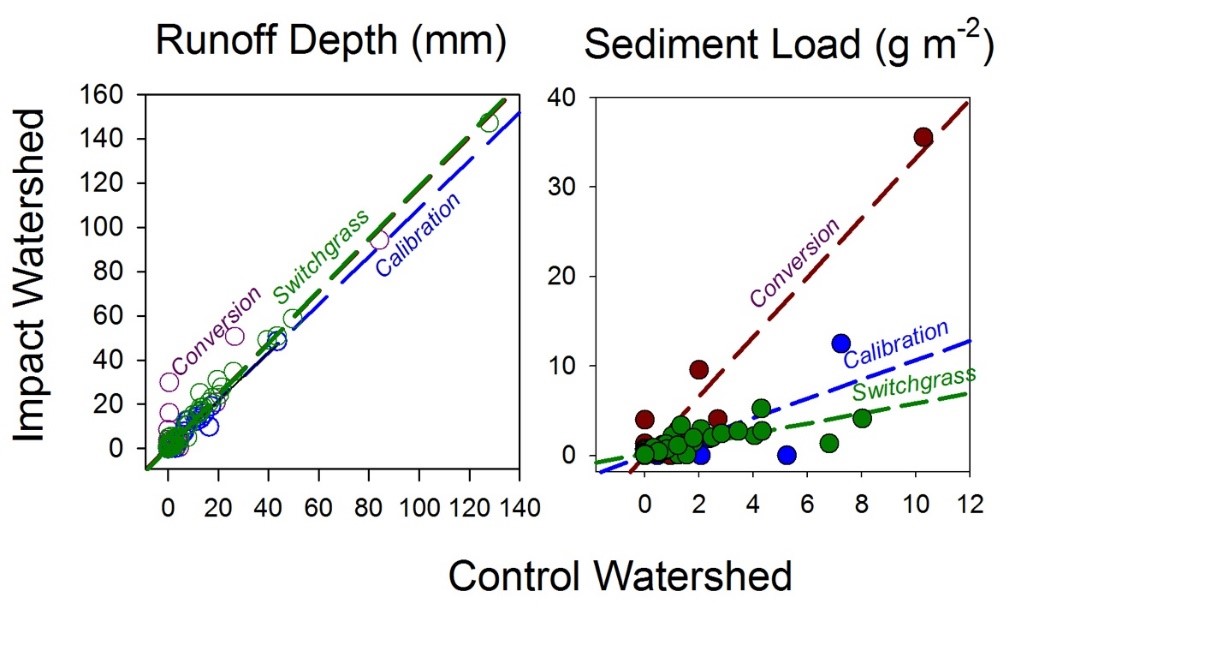
Switchgrass Conversion of Marginal Grassland = Min. Impacts Land/Water Systems
EPSCoR Update - Sept. 2022
The Southern Great Plains (SGP) is dominated by mixed grass and short-grass prairie ecosystems that provide habitat for wildlife, outdoor recreation, and food for cattle production. The surface runoff generated from these grasslands serves as an important water source for the streams, farm ponds, and reservoirs, which are critical for irrigation and municipal water supplies. Active management of surface runoff is imperative to ensure sufficient supply during drought and to prevent flooding during fluvial events. The SGP has the highest density of surface impoundments in the U.S. that are built to store runoff. Such a unique hydroscape provides a wide range of soil and ecosystem services that are vulnerable to land-use and land cover (vegetation) changes within the upland watersheds.
The SGP has adequate precipitation and sufficiently productive soils for producing switchgrass, which is a perennial grass native to the Great Plains and has been promoted by the U.S. Department of Energy as a species suitable for bioenergy production. In recent years, the conversion of marginal grasslands to switchgrass biofuel feedstock for energy production has been proposed in the SGP to meet the U.S. Renewal Fuel Standard mandate.
 Previous studies have shown that established switchgrass benefited water quality and reduced soil erosion and nutrient loss in cropland systems. However, the impact of converting a marginal grassland to a switchgrass production system on water yield is unknown. Hence, Drs. Chris Zou and Rodney Will, professors of Natural Resource Ecology and Management at Oklahoma State University (OSU) collaborated with Dr. Lixia Lambert and Mr. Joshua Everett also from OSU to study land and water system dynamics (i.e., runoff and sediment yield) that were related to the conversion of a marginal grassland watershed to a switchgrass biomass production system.
Previous studies have shown that established switchgrass benefited water quality and reduced soil erosion and nutrient loss in cropland systems. However, the impact of converting a marginal grassland to a switchgrass production system on water yield is unknown. Hence, Drs. Chris Zou and Rodney Will, professors of Natural Resource Ecology and Management at Oklahoma State University (OSU) collaborated with Dr. Lixia Lambert and Mr. Joshua Everett also from OSU to study land and water system dynamics (i.e., runoff and sediment yield) that were related to the conversion of a marginal grassland watershed to a switchgrass biomass production system.
The research team conducted a paired experimental watershed study to: a) examine the change in the watershed hydrologic function by statistically testing the quantitative relationships of the event-based runoff and the sediment load from these two watersheds, and their interactions with the phases of the vegetation change (i.e., calibration, conversion, and switchgrass); b) improve the mechanistic understanding of the runoff generation potential by analyzing and comparing the monthly runoff coefficients between the paired watersheds; and c) compare the accumulated runoff depth and the sediment yield to assess the water quality and quantity impacts during the switchgrass planting and after switchgrass establishment.
The research team used two experimental watersheds that were previously established at OSU’s Range Research Station. One watershed served as the untreated Control Watershed and the second as the Impact Watershed that was converted into “Alamo” switchgrass production system.
“During the calibration period, the runoff response to precipitation was nearly identical between the two watersheds. This relationship did not change significantly during the period of land conversion nor after switchgrass establishment,” Zou said.
“We found that the sediment yield increased in the Impact Watershed during the conversion phase and decreased to levels below the calibration phase during the switchgrass establishment phase,” Everett said.
“The net effect was that, for a similar precipitation event, the sediment load increased by 332% during the conversion phase compared to the calibration phase, but it was only 56% in the switchgrass phase compared to the calibration phase,” Zou said.

Figure 1 (above): Relationships of event-based runoff and (A) sediment load (B) between the Control and Impact Watersheds during the calibration, conversion, and switchgrass phases.
“Our study implies that the conversion of grassland to a switchgrass production system will have minimum impact on the existing land water systems and will potentially minimize woody plant encroachment, which has become a significant problem on marginal grasslands in the SGP,” Will said.
____________
This work was supported by AFRI grant no. 2019–68012-29819/project accession no. 1019523, McIntire Stennis OKL03151 and OKL03152 from the USDA National Institute of Food and Agriculture and is supported in part by funding through awards from the Oklahoma Center for the Advancement of Science and Technology for project number PS20-015, the National Science Foundation under Grant No. OIA-1946093 through OK NSF EPSCoR, and the USDA_NIFA multistate Hatch Project: W4190.
For more information, refer to the entire article in Land 2022, 11(4), 540; https://doi.org/10.3390/land11040540
